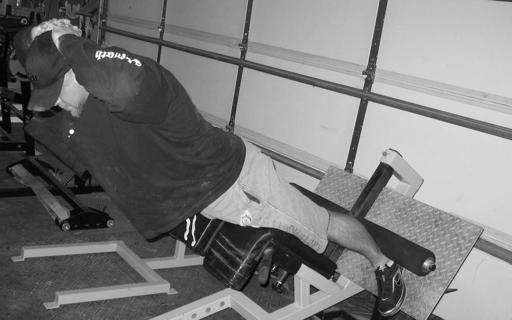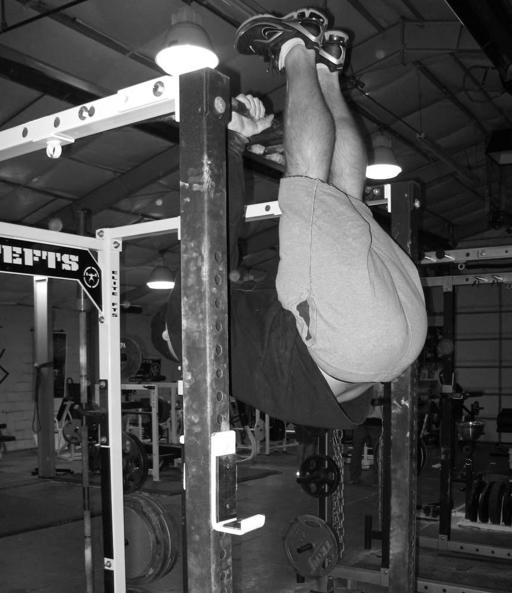5/3/1: The Simplest and Most Effective Training System for Raw Strength (2nd Edition) (6 page)
Read 5/3/1: The Simplest and Most Effective Training System for Raw Strength (2nd Edition) Online
Authors: Jim Wendler

Dumbbell Incline
Talking about dumbbel pressing is getting boring, so I’l ask the mil ion dol ar question about dumbbell incline presses: at what angle should you press? 30, 45, or 60 degrees? People will argue this ad infinitum, but the correct angle is whatever incline bench you have at your gym. If you have several different ones, use them all. Also, use a slight elbow tuck when pressing and lowering the dumbbells.
Barbell Incline
The barbell incline press is another great assistance exercise for the bench press and the military press. Again, any angle will do, so don’t sweat the smal stuff.
Lunges
The lunge has gotten a bad rap in the strength training world for two reasons. First, it’s used in the
fitness
world, and it’s championed by women for toning and firming the legs and buttocks – two body parts nestled somewhere in the Problem Region. Next, they make you really, really sore. So, combine pain and apparent pussification, and you have an exercise that few people want to do.
These people are wrong. Lunges are great for building leg strength and mass. Of course, when you introduce these into the strength training world, the first thing you’l do is add a plate to whatever weight the “regular people” are using. This usual y results in you doing a real y bad genuflect, followed by a rounded-back get-up.
Awful
.
Take big strides, maintain an upright torso and do them right. Dumbbells, barbells, weight vest, bodyweight…
doesn’t matter
. Walking lunge, backwards lunge…
doesn’t matter
. Side lunges are kind of lame, though.
Step-ups
Remember when all the Olympic lifters thought the Bulgarians replaced squats with step-ups?
And since they couldn’t think for themselves, they did too? Remember when they realized the joke was on them? I still laugh about that today. In any case, the step-up is a great exercise for your legs and ass. Just don’t be Cheater McCheaterstein and use a box that’s 10” off the ground, push off with your back leg like a donkey, then post on message boards how you did
315x10 with each leg on step-ups. Actually, the worst part of this whole scenario is you posting on message boards.
As with lunges, you can use a variety of implements and different box heights. A general guideline is to use a box that puts your leg at about parallel to the ground. Single leg movements will reveal coordination, strength and balance problems in the body. Instead of wasting 14 days of assessments, you can do some one leg movements, squatting, deadlifting and Blast Strap pushups and get all your answers in about ten minutes.
Leg Press
I’m not a huge leg press fan, but I can see its value. It’s not squatting, but it’l help strengthen and build your legs. The leg press is a machine, so I’m not going to tell you how to use it. Just use a full range of motion, and never use knee wraps.
Back Raise

Done on a back raise bench, a glute-ham bench or a 45-degree back raise bench, this movement is a simple and effective way to strengthen your lower back and hamstrings. Extra resistance can be added by putting a bar across your back. You can also attach a band to the bottom of the machine and put it around your neck, hold a plate in your hands or behind your head, or wear a weight vest.
Back raises are like very strict good mornings without the politics. Loading this exercise can be somewhat awkward. Holding a 10 pound plate in your hands is one thing, but putting 135
pounds on your back and getting into position is a pain in the ass.
Good Morning
The first mistake people make with good mornings is treating the exercise as a movement and not as a muscle builder/strengthener. When it’s used as a movement, form is usual y thrown out the window, and weight is all that matters. This is not a good idea. The good morning is used to build your lower back and hamstrings, so perform the exercise in a way that hits these muscles
correctly. This means pushing your butt way back, trying to keep somewhat of an arch in your back, and using as full a range of motion as you can. Don’t be Half Rep McGee.
You don’t have to go very heavy on these. I’ve used 500 pound loads with this movement, but I’ve gotten more out of doing 185 for strict reps.
Glute Ham Raise
Nothing works the hamstrings like glute-ham raises. Add in a full range of motion – from the bottom to the top – and you have an exercise that works the low back, hamstrings and calves.
Not too shabby. If you suck at these, do them every day until you don’t. Start each workout with 2-3 sets of 5 reps. Do this, and pretty soon you won’t suck.
Here are my thoughts on the GHR, and how the exercise should be done: You MUST start with the motion of a back raise. The reason for this is to achieve a full range of motion and get some kind of erector work in during the movement. This action allows the GHR to be a thorough posterior chain movement. Having strong erectors for any sport is essential. Hel , it’s important in LIFE.
If you real y can’t perform a rep, either use a band (attached to the back of the machine and held in your hands by your head), or have a partner assist you.
Once you can perform reps on your own, hold your hands and arms out in front of you as though you’re holding a barbel .
The next step in the progression is to fold your hands on your chest like a sleeping vampire.
Once you’ve mastered the vampire position, pinch your earlobes with your fingers OR
interlock your fingers with your hands behind your head.
5 sets of 10-15 reps with your bodyweight in this position should be achieved before you’re ready to perform weighted GHR's.
Add weight by holding a plate or putting it behind your head, using a weight vest or using a band. I recommend using a full range of motion to involve your lower back.
Sit-ups
You can do these on a glute-ham raise bench or a Roman chair. You can do them on the ground. You can do them with your feet anchored down. You can do them with your feet not anchored down. You can use bodyweight, or you can hold a plate behind your head, but please don’t be that guy who does them while holding a plate, dumbbell – or, even worse, a medicine ball – on his chest. This is lame, and it doesn’t do anything. Hold the weight behind your head and prepare to be humbled.
Dumbbell Side Bends
These are good for your abs, low back and obliques. If you’re strict enough with them, and you use some heavy weight, everything will be sore. I recommend doing sets of 15-20, and don’t use straps.

Hanging Leg Raises
These are popular with people who want to improve their ability to swing their legs and knees up while doing nothing for their abs, yet still want to call it ab work. To combat this, hang from a bar, and with straight legs, bring your feet to the bar. Return to the starting position, come to a complete stop, and begin the movement again. When you do it this way, you’l no longer ask about sets and reps because your body will tell you when a set is over.
Abdominal Wheel
The ab wheel made a comeback several years ago. Even though 90% of the people who bought it ended up throwing it in their garage, it was good to see a classic get some respect – at least until they started hooking up small motors to them to make it easier. This is akin to putting a baby seat in Grave Digger. Just kills the whole thing.
Do these on your knees for some reps, and on your feet to test yourself out. Try not to sag or A-frame too much. If you’re on your knees, I recommend sets of 25-50.
How to Have Stronger Abs
If you ever are confused about what to do for abs, this is a simple abdominal circuit that we did for years when I first began powerlifting. At that time, my abs and low back were my weak point. For lower back, we did high rep barbell good mornings (sets of 10) and the following abdominal circuit. This was done 3-4 days per week.
Weighted Sit-ups – 25 or 45lb plate held behind head for 10 reps Hanging Leg Raises – 10 reps
Abdominal Wheel – 15 reps
Side Bends – 100lb DB for 20 reps/side
These exercises were done right after each other (no…you don’t run to each one and there is no time between exercises. Just do it.) We started with 2 times through for 2 weeks. Then did 3 times through for 2 weeks .After 4 weeks we were doing this 4 times through. Simple. Easy.
Effective.
The Great Debate
The big debate with ab work is whether to do a lot of sets and reps (5x12, for example), or to work up to one heavy set – sort of the way you do with this program. There’s no right or wrong answer for this. I usually tell people to do both. Some exercises are better with higher volume – face pulls and triceps pushdowns, for example – while others should be loaded fairly heavily and rep maxes should be established.
The drawback of always relying on just one of these principles is that sometimes you can’t go for a rep max – or don’t feel like it – after punishing yourself on the first exercise. The higher volume approach hits something of a snag when the opposite is true: you feel great and strong and want to work up to something heavy. My advice? Make some of these lifts a game time decision. See how you feel. For example, if you want to do dumbbell bench presses as an assistance exercise after you bench press, and you feel great, do one or two progressive sets and one all-out set. Here’s an example:
80x10
100x10
130x16
Track your personal records on some of your assistance lifts. When you feel great, try to break them. If you don’t feel like going crazy with a lift, simply back off the weight and perform more reps (i.e., 4x12 with 80 pounds).
Side Note: Train Like a Bodybuilder
Whenever I say this, people cringe and run for cover, but there’s a method to my madness.
What’s the goal of a bodybuilder? Not size or strength, but
symmetry
. They want their bodies to be symmetrical, from front to back and from side to side. This is how you have to think, and this is why there’s a growing fascination with weak points and the posterior chain. It’s also why so many injuries occur. When I tell you to train like a bodybuilder, I just want
balance
in your training. If you train your chest, train your back. If you train explosively with weights, train your conditioning level. If you train your conditioning, train your flexibility.
